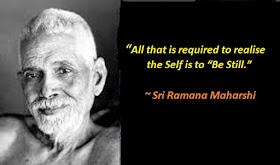Awareness is the
always present substratum that permeates, illuminates both, the external world, (the space and the objects that appear in it) and the mental world (the mental space and the thoughts which are mental objects) and makes them perceiveble. Awareness is always present because without awareness there
is no perception; but in perception, awareness is mixed up with the perceptional objects, weither is a form (sensory object or a thought), or the space (external or the mental space: these are also objects in awareness although very subtle).
Awareness is always present, in every perception or experience we have. Then why teachers give such importance to achieve a thoughtless state? Because when there is
absence of objects and thoughts it is much easier to be aware of awareness itself and also because we can realize perfectly our essence or awareness when there is total absence of all perceptions. However we can be
aware of awareness even when objects are present, although it is very difficult
or quite impossible for the majority due to indiscrimination, identification
and the rajas and tamas gunas. One more important reason to still the mind is that the bliss aspect of awareness can be experienced only in a calm, serene free from thoughts mind focused in its source (awareness).
When thoughts subside the mind becomes calm and thus there is not much distraction of
attention; moreover when thoughts subside the emotions and the ego itself which is the main
obstruction to realize clearly our true Self subside too. The ego and the emotions which are modifiocations of the ego use the thinking mind (the thoughts) in order to be manifested and feed themselves by vibrations of similar frequency. Through the control of mind we try to pacify our emotions and the ego itself. When emotions subside then mind becomes easily calm and serene and the ego assumes a subtle state. When the ego subsides
there is no distraction; our attention naturally and effortlessly rests in its source (Awareness, Essence, Beingness) and we experience without
obstruction our essence in the ´form' of silence, peace, plenitude, love,
freedom, luminosity and bliss.
Of course there are different ways or techniques to concentrate the mind and pacify the emotions. According my own experience in order to create the best possible condition to meditate is to start our session with some hatha yoga asanas, continue with pranayama and then with the recitation of some prayers and mantras. Thus we prepare gradually our body, energy, emotional and thinking mind to be relaxed and concentrated.
As I mentioned above the ego or 'Iness is the core
factor that impedes us be aware
of our true nature. The ego
is the real problem because it is what causes the illusory identifications, ptrojections and superimpositions.
Ego causes the compulsvive mecahnical thiniking and the emotional reactions as well as the identification with thoughts, emotions,
sensations and physical forms and entraps our attention in them. The ego also by identification, projection and superimposesition makes us perceive the unreal
us real (viz. the ego and the objects -mental and physical- as real) and the
qualities of the true Self (Atman, Awareness) as qualities of the body and the
ego. Thus the ego impedes us to discriminate between the real
(our Beingness the unmovable substratum of all experiences) and the unreal (all
passing forms subtle and gross) and entraps our attention in the forms
(physical, energetic or mental).
The qualities that operate through the ego and cause the
identifications and projections are the rajas and tamas gunas . Tamas guna is the veiling factor; is what puts a veil in
our mind that obstructs as realize our true Self and rajas is the distractive
and extroverted factor; is what distracts our mind and drives it to the
external objects to find pleasure. These two gunas and ego cloud the buddhi and
obscure its clarity, luminosity and the discriminative capacity; thus we fail
to realize our true Self .
Without a high capacity of discrimination (viveka) we fail to discriminate between the Self and the non-Self*, between the unmovable, silent, peaceful substratum of
our experiences which is the consciousness (the Self, the silent witness) and
the non-Self (the (five koshas, the threee bodies).
While we are meditating, and there is a prolonged gap between
thoughts, exist three factors: the sense of ego (the sense I meditate), the
mental space or a void and the awareness. If we are well focused and we
can maintain the mind empty of thoughts then arises the possibility to discern
awareness as the immovable silent substratum of ego and the void and that we
are this silent awareness. According my experience to discern clearly the Self
from the experienced objects gross or subtle is a matter of purity of mind, right
knowledge, understanding, discrimination, one-pointness of mind and the grace of God .
It is certain that the 'perception' of our true nature becomes
clear when the mind is still and the ego-sense subsides, because the ego is the main cause
that keeps our attention downward, outward and distracted (causing the mental and emotional manifestations and the identification with them), and also the ego like a cloud covers our essence.
Thus the clear perception of our essence is achieved in the
savikalpa samadhi when the ego assumes a very subtle form and perfectly in
Nirvikalpa samadhi in which the ego subsides totally. We can experience
continuously and effortlessly the peace and bliss of our true Self after the
total dissolution of the ego, root and branches, which happens in
profound Nirvikalpa samadhi.

